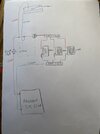I don't understand your system.
The HW cylinder feed connection is not shown - is it before or after the pump?
Changing the red pipe to the tank to an up-and-over vent (no connection below the water level) would prevent the unwanted flow loop from the tank, and give better venting.
The HW cylinder feed connection is not shown - is it before or after the pump?
So you get thermosiphon up the red pipe and down the blue from the header tank? I can't see any benefit of that, and warming the header tank is undesirable as it can lead to algae growth.The hot flow pipe goes from the stove up into the cistern via the check valve.
The swing check valve needs to open for the thermosiphon to happen.The swing check valve can always open and let water into the cistern if the water expands too much.
So why do you want the thermosiphon through the boiler only? Maybe the current arrangement doesn't vent air adequately, causing the pump noise.The system can thermosiphon with the cistern initially
Changing the red pipe to the tank to an up-and-over vent (no connection below the water level) would prevent the unwanted flow loop from the tank, and give better venting.
There's no need, expansion can via the blue pipe.The swing check valve can always open and let water into the cistern if the water expands too much.


